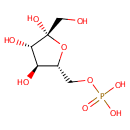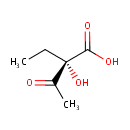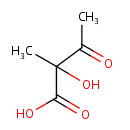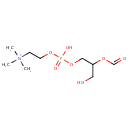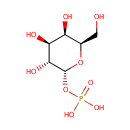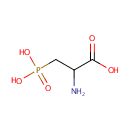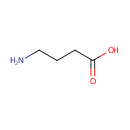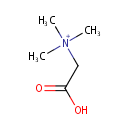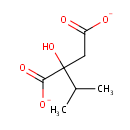
Search Results for compounds
Searching compounds for
returned 4373 results.
beta-D-Fructose 6-phosphate (PAMDB000547)
IUPAC:
{[(2R,3S,4S,5R)-3,4,5-trihydroxy-5-(hydroxymethyl)oxolan-2-yl]methoxy}phosphonic acid
CAS: Not Available
Description: Beta-D-Fructose 6 phosphate (b-F6P) is the beta-anomer of fructose-6-phosphate. There are two anomers of fructose 6 phosphate, the alpha anomer and the beta anomer. Specifically, beta-D-fructose 6-phosphate is fructose sugar phosphorylated on carbon 6. Beta-D-Fructose 6-phosphate is a substrate for Fructose-1,6-bisphosphatase, Pyruvate kinase (isozymes R/L), Hexokinase (type I), Fructose-bisphosphate aldolase A, L-lactate dehydrogenase B chain, Glyceraldehyde-3-phosphate dehydrogenase and Transaldolase.
Oxalosuccinic acid (PAMDB000548)
IUPAC:
1-oxopropane-1,2,3-tricarboxylic acid
CAS: 1948-82-9
Description: Oxalosuccinate is a substrate for cytoplasmic Isocitrate dehydrogenase and mitochondiral Isocitrate dehydrogenase (mitochondrial).
2-Aceto-2-hydroxy-butyrate (PAMDB000549)
IUPAC:
(2S)-2-ethyl-2-hydroxy-3-oxobutanoic acid
CAS: 3142-65-2
Description: (S)-2-Aceto-2-hydroxybutanoic acid is an intermediate in branched chain amino acid metabolism. It is converted from 2-oxobutanoate or 2-hydoxyethyl ThPP via acetolactate synthase.
2-Acetolactate (PAMDB000550)
IUPAC:
2-hydroxy-2-methyl-3-oxobutanoic acid
CAS: Not Available
Description: 2-Acetolactate is involved in the butanoate metabolism and pantothenate and CoA biosynthesis pathways.
2-Acylglycerophosphocholine (PAMDB000551)
IUPAC:
[2-(formyloxy)-3-hydroxypropoxy][2-(trimethylazaniumyl)ethoxy]phosphinic acid
CAS: Not Available
Description: 2-acylglycerophosphocholine belongs to the class of Lysophosphatidylcholines. These are glycerophosphocholines (molecules containing a choline moiety attached to the phosphate group linked to a glycerol) in which the glycerol is attached to one saturated fatty acid each through an ester linkage. (inferred from compound structure)2-acyl-sn-glycero-3-phosphocholines are a class of phospholipids that are intermediates in the metabolism of lipids. Because they result from the hydrolysis of an acyl group from the sn-1 position of phosphatidylcholine, they are also called 1-lysophosphatidylcholine (or 1-lysoPC, in short). The synthesis of phosphatidylcholines with specific fatty acids occurs through the synthesis of 1-lysoPC. The formation of various other lipids generates 1-lysoPC as a by-product. Other synonyms for this class of compounds are 2-acylglycero-3-phosphocholine, 1-lyso-2-acyl-sn-glycero-3-phosphocholine, β-lysophosphatidylcholine, 2-acylglycerophosphocholine, L-1-lysolecithin and 1-lecithin. (WikiPedia)
Galactose 1-phosphate (PAMDB000556)
IUPAC:
{[(2R,3R,4S,5R,6R)-3,4,5-trihydroxy-6-(hydroxymethyl)oxan-2-yl]oxy}phosphonic acid
CAS: 2255-14-3
Description: Galactose 1-phosphate is an intermediate in the Galactose metabolism
1-Amino-propan-2-one-3-phosphate (PAMDB000559)
IUPAC:
2-amino-3-phosphonopropanoic acid
CAS: 5652-28-8
Description: 1-amino-propan-2-one-3-phosphate is a normal Pseudomonas aeruginosa metabolite in pyridoxal 5'-phosphate biosynthesis pathway. It is formed by the conversion from (2S)-2-amino-3-oxo-4-phosphonooxybutanoate. With 1-deoxy-D-xylulose 5-phosphate, it is converted to pyridoxine-5'-phosphate. (EcoCyc)
gamma-Aminobutyric acid (PAMDB000561)
IUPAC:
4-aminobutanoic acid
CAS: 56-12-2
Description: Gamma-aminobutyric acid (GABA) is a metabolite of glutamate. Gamma-aminobutyric acid was first synthesized in 1883, and was first known only as a plant and microbial metabolic product. In 1950, however, GABA was discovered to be an integral part of the mammalian central nervous system. Organisms synthesize GABA from glutamate using the enzyme L-glutamic acid decarboxylase and pyridoxal phosphate (which is the active form of vitamin B6) as a cofactor. (Wikipedia)
Betaine (PAMDB000564)
IUPAC:
(carboxymethyl)trimethylazanium
CAS: 107-43-7
Description: Betaine or trimethylglycine is a methylated derivative of glycine. It functions as a methyl donor in that it carries and donates methyl functional groups to facilitate necessary chemical processes. Betaine is an osmoprotectant compound. The accumulation of betaine increases the volume of cytoplasmic water of Pseudomonas aeruginosa and increases the growth rate of osmotically stressed Pseudomonas aeruginosa.
3-Carboxy-3-hydroxy-isocaproate (PAMDB000567)
IUPAC:
2-hydroxy-2-(propan-2-yl)butanedioate
CAS: Not Available
Description: 3-carboxy-3-hydroxy-isocaproate is a member of the chemical class known as Dicarboxylic Acids and Derivatives. These are organic compounds containing exactly two carboxylic acid groups. Alpha isopropylmalate is involved in the biosynthesis of leucine. The protein product of MJ0720 was found to be alpha-isopropylmalate dehydrogenase (LeuB) and was found to catalyze the NAD-dependent decarboxylation of one isomer of DL-threo-isopropylmalate to 2-ketoisocaproate; thus, it is involved in the biosynthesis of leucine. (PMID 10940051)
